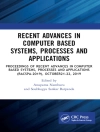This book contains research contributions from leading global scholars in nature-inspired computing. It includes comprehensive coverage of each respective topic, while also highlighting recent and future trends. The contributions provides readers with a snapshot of the state of the art in the field of nature-inspired computing and its application. This book has focus on the current researches while highlighting the empirical results along with theoretical concepts to provide a comprehensive reference for students, researchers, scholars, professionals and practitioners in the field of Advanced Artificial Intelligence, Nature-Inspired Algorithms and Soft Computing.
Cuprins
A Nature-inspired Decision System for Secure Cyber Network Architecture.- Optimizing Resource Allocation in Next-Generation Wireless Networks Considering Carrier Aggregation Using Evolutionary Programming.- Artificial Feeding Birds (AFB): a new metaheuristic inspired by the behavior of pigeons.- Nature – Inspired Algorithms for Medical Image Processing.- Firefly Algorithm applied to the Estimation of Parameters of Photovoltaic Systems.- Realization of PSO-based Adaptive Beamforming Algorithm for Smart Antennas.- A Multi-objective Analysis and Comparison of Bio-inspired Approaches for the Cluster-Head Selection problem in WSN.- An Energy Efficient Cluster Head Selection using Artificial Bees Colony Optimization for Wireless Sensor Networks.- Modified Krill Herd Algorithm for Global Numerical Optimization Problems.- Application of Nature-Inspired Optimization Techniques in Vessel Traffic Control.- Enhanced throughput and accelerated detection of network attacks using a membrane computingmodel implemented on a GPU.- Physics-based Algorithms for Boolean Target Coverage.- A Hybrid Bio- Inspired Algorithm for Protein Domain Problems.- Modeling Service Discovery over Wireless Mesh Networks.
Despre autor
Dr. Shishir K. Shandilya is a renowned academician and active researcher with proven record of teaching and research. He is Cambridge University Certified Professional Teacher and Trainer, Senior Member of IEEE-USA and also elected as an executive member of IEEE Industry-Outreach Committee-India. Dr. Shandilya has received “IDA Teaching Excellence Award” for distinctive use of Technology in Teaching by Indian Didactics Association, Bangalore (2016) and “Young Scientist Award” for consecutive two years (2005 & 2006) by Indian Science Congress & MP Council of Science & Technology. He has written seven books of international-fame (published in USA, Denmark and India) and published over 50 quality research papers. He is an active member of various international professional bodies.
Smita Shandilya (Senior Member-IEEE) is an eminent scholar and researcher. She has over 20 quality research papers to her credits. She has delivered several invited talks in national seminars of high repute. Her research interests are Power System Planning and Smart Micro Grids. She is also involved in the establishment of Energy Lab in the Institute (first in any Private Institute in M.P.), and Establishment of Training cum Incubator centre in Collaboration with i Energy Pvt. Ltd.
Atulya K. Nagar holds the Foundation Chair as Professor of Mathematical Sciences and is Dean of the Faculty of Science at Liverpool Hope University, UK; he has been the Head of Department of Mathematics and Computer Science which he established at the University. Professor Nagar is an internationally respected scholar working at the cutting edge of theoretical computer science, applied mathematical analysis, operations research, and systems engineering. He received a prestigious Commonwealth Fellowship for pursuing his doctorate (DPhil) in Applied Non-Linear Mathematics, which he earned from the University of York (UK) in 1996; and he holds BSc (Hons.), MSc, and MPhil (with Distinction) in Mathematical Physics from the MDS University of Ajmer, India. Professor Nagar’s research expertise spans both Applied Mathematics and Computational Methods for nonlinear, complex and intractable problems arising in Science, Engineering, and Industry. In problems like these the effect is known, but the cause is not. In this approach of mathematics, also known as ‘Inverse Problems’, sophisticated mathematical modelling and computational algorithms are required to understand such behaviour.












